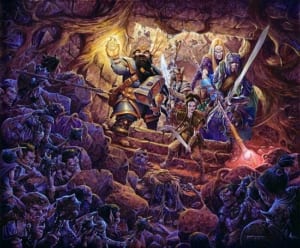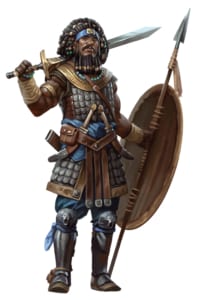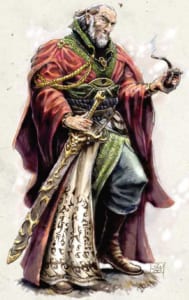Greetings, readers of the Fandomentals! I’ve written about tabletop gaming in the past, including two direct introductions to certain titles, and others that touched on them indirectly. This time, I would like to dissect a subject I think might be controversial: D&D. No, not David Benioff and D. B. Weiss, the showrunners to Game of Thrones. The original D&D, Dungeons & Dragons, specifically, what I find to be inherent fault-lines in the gaming franchise.
That Dungeons & Dragons, in most of its iterations, has balance problems, is not a new claim. The one edition that doesn’t is the 4th. Which is not to say it’s perfectly balanced, just that it doesn’t have the striking balance issues that other editions do. And the way in which it avoids them brings its own issues.
This is a topic that others have discussed to death and beyond. Many actually claim the games have no balance problems. Others, that the imbalance is natural, intentional, and desirable. My stance is that it is at least partly intentional, but not desirable, nor does it have a good effect on the franchise. But I want to talk about something more specific. As I said, the topic of balance has been driven to the ground and run over with a steam roller. Instead, I would like to cut to the heart of the matter, and unpack some basic conflicts in D&D’s power curve that cause many of its problems to happen.
Level Progression
As you play D&D, you go up in levels. This is obvious. The concept of a “level up” has entered the gaming terminology and made itself at home, so that even people who don’t play games, or play them only casually, will usually know what it means.
And yet… as much as you see it in video games, D&D is among the few tabletop games that still uses levels. There are different reasons why I think levels are inefficient, but here I’m going to focus on a particular aspect thereof.
My thesis is this, D&D tries to combine different genres, but it puts them on the same leveling curve, with very little regard for how one segues into the next. Covering different genres and levels of play is nothing unusual. We’ve got systems like GURPS or FATE, which are explicitly intended to cover all sorts of stories, with players and gamemasters adjusting them as necessary. Chronicles of Darkness covers both ordinary mortal humans and supernatural beings, which vary from vampires or werewolves to mages who casually rewrite reality, and mummies with Biblical powers.
D&D offers a fairly rare “zero to hero” curve. Or, if you play long enough, “zero to virtual demigod”. The exact power levels depend on edition, granted. In very general terms, you start out as avery weak character. Particularly in the old-school era, the expectation was that you would avoid trouble, rather than actually tackle it head-on. And there was every expectation your character wouldn’t make it. At which point you’d make another one.
The 3rd edition reduced the mortality rate, but low levels are still very much a comedy of errors. A good hit can put someone on the brink of death and magic users have a handful of spells they can cast, not counting cantrips. The 4th edition removes that tier of play, and has the players start out as fairly competent. The 5th takes something of a middle road, but low-level characters are still not as inept as they were in 3e and prior. As a disclaimer, the 4th edition is different in many ways. While it’s still D&D through and through, many expectations do not apply.
Once you hit level 6 or 7, the game is noticeably different. You’re no longer a bumbling band of misfits; the heroes become competent and in many ways larger-than-life. The party can take on an entire warband of conveniently evil humanoids and rout them without breaking a sweat. Likewise with a town guard, a militia, or a regiment of soldiers
Moving onto level 10 and early teens, the game shifts even more, becoming a story of magical superheroes and their less-magical sidekicks. The concerns of the world at large become increasingly irrelevant, particularly if magic enters the picture. Even without magic, those characters are absolutely superhuman. Or superelven, et cetera. You know what I mean. Past level 15, magic-using characters achieve a level of power comparable only to others of their kind, and the world around them mostly ceases to matter.
The problem here is twofold. The first is that the game advances from genre to genre with very little understanding of how the experience changes. There are level 3 spells that can let you walk on water and create food out of thin air. Those are feats that some real-life religions have put forward as miracles performed by God, the Messiah, or the prophets.
While such powers are hardly unique, what sets D&D apart is that an adventurer can move on from being a mostly down to earth person to a minor superhero and a world-class one simply by overcoming increasingly difficult challenges.
In Exalted, the Solars are fairly close to high-level D&D characters in terms of power. Many of their powers even emulate incredibly puissant human skill. But a mortal isn’t going to become a Solar, or any other kind of Exalt, just by beating up enough bad guys. Becoming Exalted is a profound event that realizes a mortal’s heroic potential, whether it’s because the Unconquered Sun chose them, Luna did, the blood of the Elemental Dragons came to the fore, or something else. And, of course, Exalted is very much aware of the effects mighty demigods have on the world around them. D&D is very reluctant to have the capabilities of high-level characters truly affect the pseudo-medieval fantasy world it presents.
Here is where levels come in, as well. The only way to advance is to gain a level. But that puts you one step closer to a completely different level of play. Whatever you do, the increase in health and passive numbers is merciless. Likewise with spells.
This is especially painful for characters without spellcasting. Without using some fairly controversial material like Tome of Battle (or Path of War in “Pathfinder”), the only way they learn anything is through feats or class features. Feats are a very scarce resource, and class features are preordained.
The only way to keep playing on a level you want is to artificially halt the flow of levels, which is something people have done. E6 is a thought experiment that gained traction some years ago, when the 3rd edition was dominant. It means stopping advancement on level 6. Following that, you gain feats, but no new levels, Hit Dice, spells, or features.
 The relative popularity of such a simple idea is telling, I think. It captures the “sweet spot” where D&D feels most like… itself, I suppose. Reasonably competent heroes who won’t die to a conveniently evil humanoid’s lucky shot, but don’t crush 90% of the world under their heels just yet. The characters still gain feats, so there is an element of advancement. Particularly if you use the full range of 3e’s splatbooks, which give you a list of feats to blot out the sun.
The relative popularity of such a simple idea is telling, I think. It captures the “sweet spot” where D&D feels most like… itself, I suppose. Reasonably competent heroes who won’t die to a conveniently evil humanoid’s lucky shot, but don’t crush 90% of the world under their heels just yet. The characters still gain feats, so there is an element of advancement. Particularly if you use the full range of 3e’s splatbooks, which give you a list of feats to blot out the sun.
The bigger issue, however, may be that most of what I’m talking about are the system’s emergent properties; it’s what might or might not come out in play. It’s difficult to say what the franchise’s intentions were for the power progression. The earlier versions, before 3e, generally expected characters beyond level 10 or so to “retire”. They’d get their own land, followers and resources, while no longer adventuring. Of course, it was not only vague, but also often arbitrary. Why does a fighter need to get a castle and soldiers, becoming a feudal (or kinda-sorta-pseudo feudal, anyway) lord or lady? Why does a thief need a literal thieves’ guild? And so on. There are many ways such characters can extend their reach beyond the length of their arms.
Not only that, but why should a high-level character stop being active? They have more reason than ever to go out and actively pursue their goals. A high-level wizard (or mage or magic-user, in older editions) can teleport in a flash and demolish a city with area-of-effect spells. Or turn someone into a toad. Or mind-control them. A high-level fighter or similar class may be pretty sad compared to that, but they can still lead armies with the knowledge that there’s not much that can actually threaten them, unless they run into a level-appropriate monster or another adventurer. Rogues… well, they can sneak around really well, I suppose. The franchise has always treated non-magical characters without a combat focus as an afterthought.
The 3rd edition removed such considerations, promising a whole wide range of power. But there’s clearly some foresight lacking from high levels, and it gets worse the higher you go. The 5th edition curbs the power gain… in some places. It’s mostly non-magical and non-combat skills that are forbidden from ever improving much; hit points increase as they have since 3e and spells go all the way up to ninth levels.
As I said before, 4e is different from the others in this regard. It flattens the curve on early levels, removing the comedy of errors the earliest ones otherwise have. It’s also the only D&D game to make an actual effort to differentiate tiers of play and set out expectations for each one. Levels 1-10 are the Heroic tier; 11-20 are Paragon and 21-30 are Epic.
Unfortunately, the effort is rather half-hearted. Upper tiers of play suffer from being mostly the same thing, just with bigger numbers. The problem had always been there, mind you, for non-magical characters. 4e applies it across the board. It’s also fairly clear that the Heroic tier received the most attention once more. It’s where they expect people to play. They’re not wrong, but maybe they should be a little more honest about it.
Another facet of that is that when you make a direct line from one genre to another, with characters being perfectly capable of crossing between them in the course of a single campaign, the rules might stop fitting them. Rules that worked (mostly) for a low-level adventure aren’t going to hold up in a high-stakes superhero-tier conflict just by making the numbers bigger. It requires a shift in assumptions, which no D&D edition was really willing to make.
All of this is why I think D&D has a serious identity problem. It doesn’t know what it wants to be and is pretty dishonest to the players about it. But it’s interwoven with another problem, one that’s guaranteed to kick-start a flamewar. I mean, of course…
The Issue of Magic
Magic. The dominance of magic in the game has been the subject of many a furious debate. Does it exist? Is it good or bad? What to do about it? I’d rather not retread more of it than is necessary, so I will focus on a specific topic. Namely, that part of magic’s dominance is connected to D&D ’s identity problem.
Much like with the overall power level, I feel like D&D magic is a victim of trying to have its cake and eat it too. The dominance of magic over other forms of skill is at least partially intentional. D&D has never been a shining beacon of good design, but there’s too much for it to have happened on accident.
As with other things, it’s not inherently bad. The issue is with presentation and conflicting messages. It’s one thing to create a fantasy world there magic is inherently superior and people without it must struggle to keep up. It’s entirely another to apply it gradually, and keep acting as if the inter-party dynamic remains the same.
 The fiction that accompanies D&D is not shy about putting dedicated spell-casters, like wizards and clerics, on a pedestal. Particularly the fiction relating to the “Forgotten Realms”. I have a lot of nostalgia for the setting, but it’s basically kind of a love letter to Ed Greenwood’s super-cool wizard OC. And most of the other people who matter are also wizards or clerics. With some sorcerers mixed in, after 3e came out. The novels that star the iconic Drizzt make it a bit less clear, though. For all their craft, wizards crumple pretty easily when a hero like Drizzt, Wulfgar, or Bruenor comes charging in.
The fiction that accompanies D&D is not shy about putting dedicated spell-casters, like wizards and clerics, on a pedestal. Particularly the fiction relating to the “Forgotten Realms”. I have a lot of nostalgia for the setting, but it’s basically kind of a love letter to Ed Greenwood’s super-cool wizard OC. And most of the other people who matter are also wizards or clerics. With some sorcerers mixed in, after 3e came out. The novels that star the iconic Drizzt make it a bit less clear, though. For all their craft, wizards crumple pretty easily when a hero like Drizzt, Wulfgar, or Bruenor comes charging in.
Again, there’s nothing wrong with a world where magic-users achieve levels of power those without direct command of magic can’t reach. That’s honestly a major part of modern fantasy. Where D&D is unique is that it tries to put them on the same level of play as heroes that it tries to pass off as realistic and “mundane”. And then it avoids the question of how it’s all supposed to work.
There are games that put supernatural characters above normal people, Chronicles of Darkness, Ars Magica, Exalted. Others restrict them enough that they don’t overshadow the Muggles, like Dark Heresy, or low-level D&D for that matter. Games that try to balance world-shaking magicians (or other supernatural people/beings) with nominally mundane heroes are comparatively rare, in my experience. Apart from D&D (in the technical sense only), there’s also GURPS, and other generic systems where power can express itself in many ways.
D&D, as a franchise, is an awkward combination of those. Low-level magic bears heavy restrictions on how often it can be used, but those restrictions have lessened over time. High-level magic can be dispelled, disrupted or blocked, but that requires, you guessed it, more magic.
Meanwhile, high-level non-magical characters perform feats that are impossible by any normal human. They’re fairly dull and unexciting feats, but they’re still up there. Wrestling a gorilla to death isn’t exactly a mundane accomplishment, and yet a high-level barbarian can do it without too much risk. I realize I just described a death-match with a gorilla as dull and unexciting, but D&D’s combat system manages to make it so.
Needless to say, it ties back to the previous topic. Different classes have entirely different advancement curves, but the franchise’s efforts to acknowledge that are half-hearted at best. Early editions mostly shrug and assume players will start over once they get past level 10, and probably earlier. From 3e onwards… well, honestly, it feels like it’s still the assumption. It’s just more tacit than before.
I said before that the topic is controversial. Part of it is that some people are perfectly fine with their non-magical characters being largely sidekicks on high levels. Standing around and fighting the non-magical enemies while the magicians unleash earth-shattering spells. Or sneaking around, stabbing non-magical enemies and doing skill checks so the big people can save up on spells.
Which would be entirely reasonable, if the game was honest and upfront about that. Which it is… sometimes. Across different editions, the issue is addressed in different ways, which feeds into the strikingly inconsistent portrayal of the issue. Part of it is that there’s really no good benchmark of what a non-magical character is on a given level – which once more brings us back to the previous problem. Is a high-level warrior Gimli? Aragorn? Achilles? Cúchulainn? It’s hard to tell if all the game gives us are numbers. And the fiction that describes those classes never really goes beyond “really good at swinging a weapon, I mean really good”.
So there’s a whole bundle of incompatible ideas there. The game wants to have magicians who cast powerful spells and shake the world to the core. It doesn’t want non-magicians to do anything too much out of ordinary. Some level of unrealistic capability is allowed, but it has to stay within a narrow aesthetic. And then it wants those characters to participate in the same party and tackle the same challenges.
Once again, I must point out that the 4th edition doesn’t have those problems. Unfortunately, the way it solved them was pretty zealous, so to speak, and brought problems of its own. Which is an entirely different topic. As is D&D’s balance in general, really. But I’ve stuck to a particular set of problems today.
To bring my ramblings back to something resembling a coherent point, I’m going to tie those two threads together. Dungeons & Dragons, as a franchise, doesn’t really know what it wants to be, and as a result, what it actually is. Many of its problems result from a lack of coherent vision. And I think they would be solvable with more transparency and clarity. But the designers aren’t very interested in anything but familiarity.

